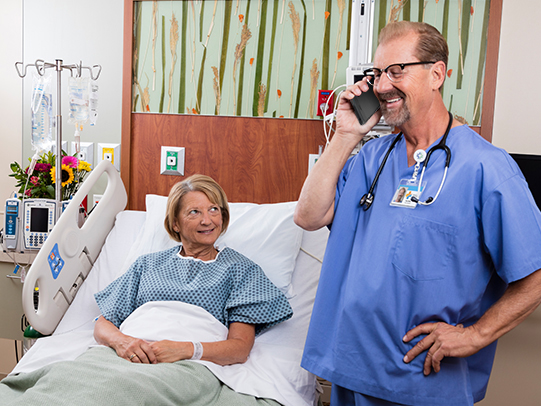Interoperability Amongst Healthcare Technologies Help Ease Clinician Burnout

 Healthcare worker burnout continues to mount even after the pandemic has started to ease. According to the Electronic Health Reporter, 47% of US healthcare workers plan to leave their jobs by 2025. Making sure that these clinicians feel valued on the job is paramount to staff retention, as recent surveys of over 20,000 physicians have indicated that burnout was at 37% where clinical workers felt valued, compared to 69% in environments where they did not feel valued. Finding ways to make this stressful job easier and show healthcare workers they matter has now become critical. But how is this accomplished?
Healthcare worker burnout continues to mount even after the pandemic has started to ease. According to the Electronic Health Reporter, 47% of US healthcare workers plan to leave their jobs by 2025. Making sure that these clinicians feel valued on the job is paramount to staff retention, as recent surveys of over 20,000 physicians have indicated that burnout was at 37% where clinical workers felt valued, compared to 69% in environments where they did not feel valued. Finding ways to make this stressful job easier and show healthcare workers they matter has now become critical. But how is this accomplished?
In a 2022 report from Elsevier, “Clinician of the Future,” many clinicians believe that in the next ten years, “technology literacy” will be even more important than “clinical technology,” but many are concerned with the further burden this will place on already stretched clinicians who may now need to learn new ways of doing things. And, ensuring that there is interoperability throughout the technology that healthcare systems put in place so that hardware like clinical smartphones or smart patient beds play well together with software/healthcare applications like Nurse Call solutions or Electronic Health Records (EHRs) is essential to help ease frustration and even save time or money troubleshooting or even replacing disparate solutions.
Taking the time to fully evaluate all of the healthcare technology being installed into a health system is imperative. During the pandemic, many hospitals rushed to install technology without thinking through their entire plan, which meant that the solutions were not fully integrated, leading to siloes, technology breakdowns, and a decrease in confidence by both management and the very clinicians these tools were designed to help.
A survey of CHIME (College of Healthcare Information Management Executives) members indicated that better integrated solutions would reduce stress on clinical workers like nurses who often have to jump between solutions. With alarm fatigue a real problem nurses face daily, finding ways to reduce this through healthcare technology solutions is critical to easing nurse burnout and improving patient care. Plus, because of this high turnover rate in clinical environments, it is more important than ever that clinical collaboration solutions are in place between multi-disciplinary care teams for more efficient patient care. And, not only would integrated systems make things easier on clinicians, but also on the IT workers behind the scenes managing these solutions: less solutions to manage that are better integrated saves time, money and frustration.
In a 2022 study conducted by symplr® and cited by Health Leaders Media, there are a few key things when considering healthcare technology solutions to help ease the burnout on both clinical workers and the IT teams supporting the technology:
- Clinical communications that leads to improved collaboration and better patient care
- Technology consolidation “through standardized, scalable enterprise solutions that enable health systems to avoid data risks and regulatory penalties while curbing costs.”
- “Patient-centric care, with new digital health and telehealth platforms that cater to patient preferences and improve the patient-provider dynamic.”
Having all of these in place will not only improve the work life of clinicians but can also help healthcare systems financially. Streamlined, integrated systems can cut down on the number of solutions that need to be purchased and maintained, there are less devices and solutions to train staff on, and they all get the same experience, and, of course, reducing the cost that staff turnover has on a healthcare system that can be achieved by giving clinical staff the right tools for the job. And, by investing in the right tools for these critical frontline workers to make their jobs easier – especially if a healthcare system gets their input on what type of handsets they’d like to carry or healthcare workflows they’d like to be able to execute easier through clinical mobility – helps to show them that they are valued. By valuing our healthcare workers, we can help ease their burdens, which hopefully will start to decrease burnout, improve satisfaction, and reduce staff turnover, reversing this trend of the last few years.
cut down on the number of solutions that need to be purchased and maintained, there are less devices and solutions to train staff on, and they all get the same experience, and, of course, reducing the cost that staff turnover has on a healthcare system that can be achieved by giving clinical staff the right tools for the job. And, by investing in the right tools for these critical frontline workers to make their jobs easier – especially if a healthcare system gets their input on what type of handsets they’d like to carry or healthcare workflows they’d like to be able to execute easier through clinical mobility – helps to show them that they are valued. By valuing our healthcare workers, we can help ease their burdens, which hopefully will start to decrease burnout, improve satisfaction, and reduce staff turnover, reversing this trend of the last few years.
For more information on how Spectralink mobility solutions can help ease the burden on your healthcre staff, visit https://www.spectralink.com/workforce-solutions/healthcare/ or complete the form below to request a demo from our team.
Contact Us
I agree to the Privacy Policy.
